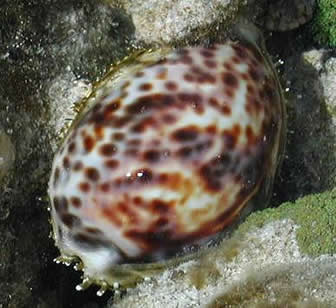Tiger cowrie - Cypraea tigris
Taxonomy
Kingdom: Animalia
Phylum: Mollusca
Class: Gastropoda
Order: Mesogastropoda
Family: Cypraeidae
Genus: Cypraea
Species: tigris
Cypraea tigrisis not listed in CITES or on the IUCN Red List of Threatened Species.
The Tiger cowrie is also known as the Tiger cowry. The plural form is always Tiger cowries.
Geographical range, habitat and habits
The Tiger cowrie lives in the Indo-Pacific. It is one of the most common molluscs in the ocean and occurs in large numbers over the majority of the tropical Indo-Pacific region, from Africa to Hawaii.
This is a nocturnal species that prefers to stay hidden during the day, e.g. among rocks or sponges.
Size and appearance
The average Tiger cowrie is about 8 cm / 3 in, while the largest known specimen is 15.3 cm / 6.02 in.
The Tiger cowrie occurs in black, gray, brown and white colours. The snail is protected by an egg-shaped shell with a spotted, shiny surface. The mantel is large and muscular and decorated with numerous papillae. In this species of snail, the mantle usually covers the entire shell, preventing encrusting creatures from settling.
The opening of the shell is lined with sharp nail-like structures that keep intruders from entering.
The Tiger cowrie is one of the most well-known sea snails and most people, even outside the aquarium hobby, know what it looks like. The shell is a common sight in souvenir shops, often engraved or painted, and there are also collectors of natural, unadulterated Tiger cowrie shells. Compared to many other snails, the Tiger cowry displays a huge range of different pattern and colour variations on the shell. These irregularities can be cause by many different factors, primarily genetic abnormalities, injury, disease, and environmental factors. Genetic factors can for instance lead to albinism, while certain diseases produce unusually large and heavy shells with a calloused, mottled appearance. Melanism – some specimens actually become completely black – can be the result of an unusually high amount of nickel or zinc in the environment, while an excess of iron can lead to a rusty appearance.
Tiger cowrie care
The Tiger cowrie is non-aggressive and non-venomous and can be kept with peaceful fish and invertebrates. Avoid housing it with aggressive and rough surfaced creatures since they may injure the soft mantle. The Tiger cowrie is considered reef safe, with caution. As it becomes larger, it may topple or damage corals as it moves around in the aquarium. This species is also fond of eating soft corals, anemones, sponges, sea stars and sea urchins.
The aquarium should ideally contain both sand and live rock, and you must provide your Tiger cowrie with suitable hiding spots where it can seek shelter during the day, e.g. caves and crevices.
The recommended water temperature is 72-78º F / 22-25.5º C, the specific gravity should be in the 1.023-1.025 range, an the pH-value at 8.1-8.4. Keep the calcium levels between 350-450 ppm to ensure proper shell growth and strength.
The Tiger cowrie is sensitive to copper and nitrates. Do not use copper based medications.
Feeding Tiger cowrie
The Tiger cowrie is a carnivore species that feeds during the night. They do for instance eat soft corals, anemones, sea urchins, sea stars, and sponges. To ensure optimal nutrition, supplement naturally occurring prey animals with meaty bits of fish and seafood. Keeping your Tiger cowrie well fed may decrease the risk of it devouring other animals in the aquarium.
Juvenile specimens have different feeding habits than the adults and feed chiefly on algae and detritus.
Breeding Tiger cowrie
In the wild, the Tiger Cowrie is generally found as a mating pair. The female snail sits on the fertilized eggs until they eventually hatch into larvae.
The Tiger Cowrie does not successfully breed in aquaria, probably because of the long larval stage. It is hard for the larva to handle life in captivity

